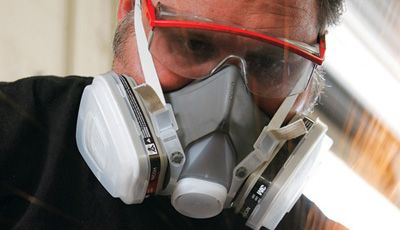
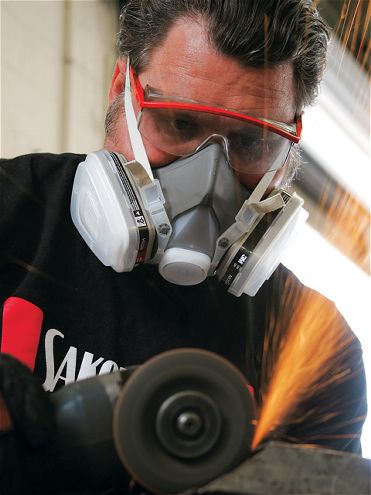 Wil Sakowski at Sakowski Motors builds cars for a living and keeps his shop stocked with respirators and filter cartridges for a variety of jobs. Here, he used a 3M 07193, with a P95 rating.
Wil Sakowski at Sakowski Motors builds cars for a living and keeps his shop stocked with respirators and filter cartridges for a variety of jobs. Here, he used a 3M 07193, with a P95 rating.
At one time, it was more common for painters not to think very much about what they were breathing inside the spray booth or in the shop. Professional bodymen and painters working in purpose-built, well-equipped shops have traditionally been a step ahead of the once-in-a-while hobbyist working out of his garage. Employers must comply with specific regulations and procedures for selecting, using, and maintaining proper respiratory protection in the workplace that are contained in standards issued by federal, state, or government agencies, such as OSHA. Do-it-yourselfers and hobbyists are not similarly regulated, and exposures are less frequent and for shorter periods of time.
The hazards of breathing in isocyanates from paint, or airborne contaminants created by grinding and sanding and working with body filler, don't just affect professionals. Today, hot rodders are more aware of safety issues associated with paint and bodywork, and there are many high-quality respirators on the market to protect our health. Some of the products are expensive and some are relatively cheap-but all of them are worth it if you consider the risks of not using the proper respirators. We in the magazine biz have gotten used to reminding our readers to wear the proper respirator when painting, but we've never looked any further at the variety of products available and how they differ according to application. Respiratory protection isn't just for painting. Bodywork and other forms of metalwork, including welding, can release airborne particulates you don't want to inhale. If you can smell it, you're breathing it. If you can't smell it, you still might be breathing it. When you're talking about health risks, why take chances?
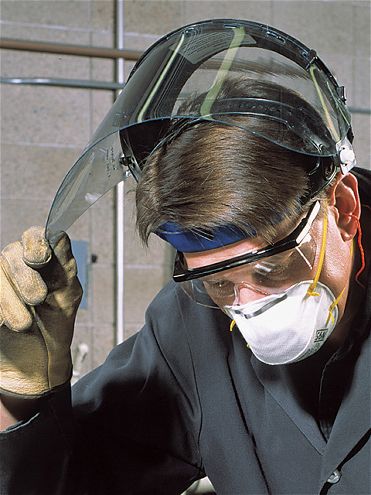 For sanding and grinding of non-hazardous materials, a NIOSH-certified N95 filtering facepiece respirator, such as the 3M 07048, is commonly suggested, along with proper eye and face protection. These inexpensive, disposable particulate respirators come 20 to a box.
For sanding and grinding of non-hazardous materials, a NIOSH-certified N95 filtering facepiece respirator, such as the 3M 07048, is commonly suggested, along with proper eye and face protection. These inexpensive, disposable particulate respirators come 20 to a box.
Cartridges
There are many companies making good-quality cartridge respirators and masks, but 3M is probably one of the best known. Its 16-page automotive respirators catalog, available on 3M's Web site, features a range of styles and designs of organic vapor (OV) cartridge respirators for painting, undercoating, grinding, welding, and other jobs. A helpful 3M Automotive Respirators Selection Chart appears on page 8 of the online catalog.
The 3M OV cartridges contain a layer of activated carbon used to reduce exposure to certain organic vapors, like those produced during painting or cleaning of spray equipment. A vapor is a substance that evaporates from a liquid or solid, such as paint thinner. The activated carbon absorbs certain organic vapors as they pass through the filter, trapping the vapors until the cartridge reaches its filtering capacity. 3M uses various filters to reduce exposure to airborne particles.
Although the products are sorted according to purpose (paint spray; grinding, sanding, and buffing; welding; and so forth), we contacted 3M for some general guidelines on choosing the right respirator for a specific job.
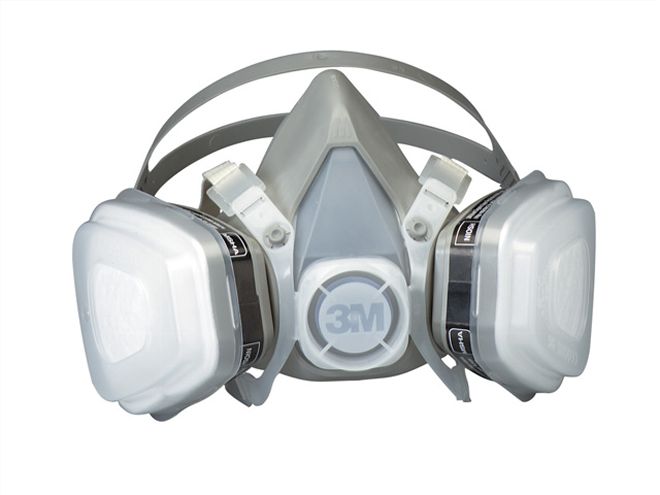 When selecting a respirator for use during the application of automotive coatings including non-urethane enamels, lacquers, primers, and waterborne coatings, or other activities that generate organic vapors, a half-facepiece respirator with organic vapor cartridges and particulate filters may be necessary. The 3M 07192 is an appropriate choice and includes one OV respirator, a pair of filter retainers, and a pair of P95 filters. At less than $20, this is considered a disposable product, though the filters are replaceable.
When selecting a respirator for use during the application of automotive coatings including non-urethane enamels, lacquers, primers, and waterborne coatings, or other activities that generate organic vapors, a half-facepiece respirator with organic vapor cartridges and particulate filters may be necessary. The 3M 07192 is an appropriate choice and includes one OV respirator, a pair of filter retainers, and a pair of P95 filters. At less than $20, this is considered a disposable product, though the filters are replaceable.
3M reps told us that, in addition to using respiratory products, other efforts to help reduce exposure to airborne contaminants are important. Adequate ventilation and proper chemical handling, mixing, and application methods can greatly reduce the amount of airborne contaminants generated. These controls should be implemented before using respirators, or in addition to using respiratory products.
After that, the first and most important step when selecting the proper respirator for DIY/hobby use is to identify whether you are being exposed to particles, gases or vapors, or both. The product label and product material safety data sheet (MSDS) will list all hazardous chemicals present, as required by law. The MSDS may also include recommendations for respirator use. Always read product warnings very carefully and call the product manufacturer if you have questions.
The do-it-yourself, non-professional hobbyist must also realize and understand that the use of respirators will only reduce the exposure to airborne contaminants; it will never completely eliminate exposure. Their effectiveness is dependant upon many factors, including the selection of the proper cartridge or filter, filter efficiency, the fit of the facepiece, and the airborne contaminant concentrations. It is also extremely important to read, understand, and follow the user instructions included with each respirator facepiece, cartridge, and filter for do-it-yourself, non-professional hobbyist applications.
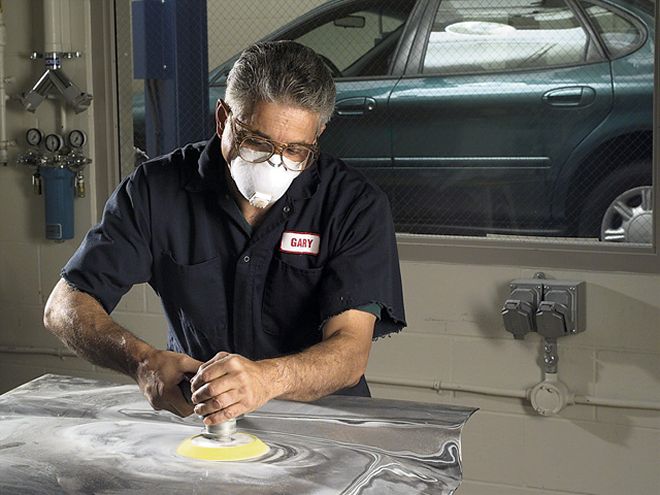 Gary can work in comfort and with peace of mind while grinding, sanding, and buffing. For this job, he wore a 3M 07185 and valved N95 disposable filtering facepiece respirator, designed for extended wear and comfort. It features a Cool Flow valve for easier breathing.
Gary can work in comfort and with peace of mind while grinding, sanding, and buffing. For this job, he wore a 3M 07185 and valved N95 disposable filtering facepiece respirator, designed for extended wear and comfort. It features a Cool Flow valve for easier breathing.
When selecting respiratory protection for occupational use, employers are required to evaluate the levels of airborne contaminants. It's unlikely that a hobbyist would be equipped to monitor their exposure levels. Using sight, taste, or smell to determine hazard levels is unreliable, since many hazardous airborne contaminants cannot be seen, tasted, or smelled. 3M strongly recommends that the application of many types of paints be left to professionals. One example is two-part urethane paints, which contain un-reacted isocyanates and should not be applied by the do-it-yourself, non-professional hobbyist.
Outside Air
Many professionals and hobbyists use supplied-air systems, which feed air directly into the respirator mask or hood. Some systems use shop air from the compressor, which works well as long as the a hobbyist has a compressor with the adequate capacity to provide air to the spray gun and to the mask, as well as suitable filter systems to remove oil mist and dirt from the supplied air. We talked to Axis Products and to SAS Safety Corporation, two manufacturers of supplied-air systems that, instead of filtering the air inside the shop, use an intake pump located in a fresh-air area (outside of the paint booth or garage) to feed clean outside air to the respirator through a hose. Both of these companies offer multiple-line systems for more than one person to use at once. Axis Products' Pro Air line has a two-person Buddy System, and SAS Safety has two-, three-, and four-man systems. Both of these companies offer all systems with your choice of mask: half-mask, full-face mask, or hood.
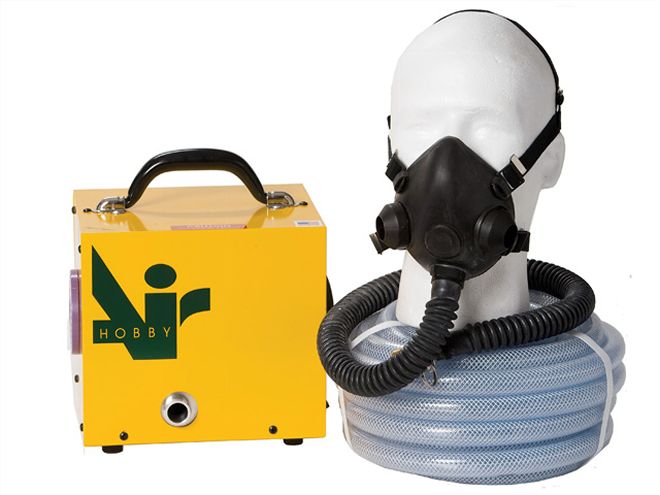 The Hobby Air line from Axis Products is a very affordable way for hobbyists and non-professionals to use a supplied-air respirator system, in applications where NIOSH approval is not required. Variations on the product include different lengths of hoses (starting at 40 feet) and different styles of face masks and hoods. The Hobby Air Buddy System comes with two air lines and masks.
The Hobby Air line from Axis Products is a very affordable way for hobbyists and non-professionals to use a supplied-air respirator system, in applications where NIOSH approval is not required. Variations on the product include different lengths of hoses (starting at 40 feet) and different styles of face masks and hoods. The Hobby Air Buddy System comes with two air lines and masks.
What Does N95 Mean?
The National Institute for Occupational Safety and Health (NIOSH) is the federal agency responsible for conducting research and making recommendations for the prevention of work-related injury and illness.
When choosing a respirator for your particular project or activity, consider looking for the NIOSH approval-such as N95, for example-to identify government-approved products. NIOSH certification means the respirator has passed stringent government performance standards, including filtration efficiency testing and gas and vapor capacity testing.
The "N95," "R95," or "P95" designations are government-approval classifications for filters used with particulate respirators. These respirators can be full-face or elastomeric half-mask facepieces. The letter signifies the type of materials appropriate for the respirator. The numeric designation signifies the minimum efficiency, as a percentage, of the filter at removing particles as tested by the government. For example, 95 indicates a minimum filter efficiency of 95 percent. The meanings of the letters are as follows:
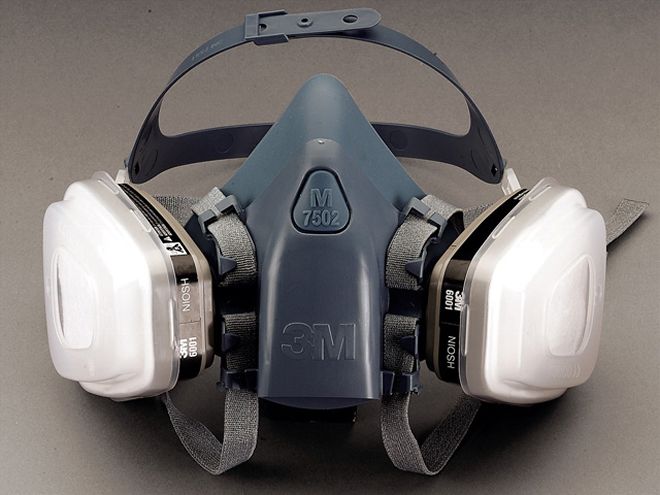 This 3M 37078 includes a reusable facepiece and, like the other 3M cartridge respirators, is available in small, medium, and large sizes. Filters for this professional-series respirator are P95-rated for protection against solid and liquid particles. Applications include paint spraying and priming.
This 3M 37078 includes a reusable facepiece and, like the other 3M cartridge respirators, is available in small, medium, and large sizes. Filters for this professional-series respirator are P95-rated for protection against solid and liquid particles. Applications include paint spraying and priming.
*N = Not resistant to oil
*R = Resistant to oil
*P = oil Proof
The N class of filter is appropriate for most common particles, including those generated from sanding and grinding. N-designated filters are the choice for solid or non-oil particulate contaminants. An R- or P-class filter would be the choice for oil mist or particles. 3M reps told us these respirators are only to be used for particles. If there are also exposures to gases or vapors, then an air-purifying respirator with a particulate filter and chemical cartridge should be used.
We discovered a chart on the Internet, titled "Standard for Filter Selection," listing NIOSH general recommendations for respirator cartridges and filters for a variety of applications. The portion of the chart shown below refers to substances related to automotive paint and bodywork.
12 Tips For Breathin' Easy
* Make sure your work environment has sufficient ventilation.
* Make sure your respirator has the proper NIOSH designation (for example, N95) for the application.
* Always inspect the respirator before using it. Throw it away if you find cracks, damaged pieces, or other defects.
* Time-use limitations may apply. Change the replacement filter cartridges frequently-at least as frequently as recommended by the manufacturer.
* Check with your local authorities for proper disposal of used respirators.
* Respirators must be worn during all times of exposure, including when mixing paint-not just when shooting it.
* Respirators are not intended for use by children or by anyone with a medical condition that might prevent the safe use of a respirator, such as asthma, emphysema, or a history of heart disease. Those people should consult their doctor before use.
* Respirator filters are working whenever they're exposed to air. Keep respirators in the sealable bag provided by the manufacturer. If you have a shop refrigerator, toss the bag inside to prolong filter life.
* Respirators offer protection only if they fit properly. Use the following test to check the fit. Cartridge-type respirators: Place your hands over the cartridge and inhale. If no air comes through, the respirator fits properly. If air comes through, readjust the straps and try again. Supplied-air respirators: Follow the manufacturer's instructions regarding required airflow. Make sure no air can come in from the outside. Report any problems, especially if you find it difficult to breathe through the mask or if you notice a strange odor or taste.
* Make sure your beard or other facial hair isn't preventing direct contact with the edge of the respirator and your face. Anything that prevents direct contact for a tight seal will reduce the effectiveness of the respirator.
* If the respirator becomes difficult to breathe through or is damaged, immediately go to a non-contaminated area and replace the respirator.
* Respirators cannot prevent contaminants from entering your body through other routes, such as through the skin. Always wear adequate personal protective equipment, like gloves or other protective clothing.
Isocyanates cannot be detected, so use a supplied-air respirator if you are working with paints containing them. 3M reps recommend leaving this to a professional painter, and they also emphasize that home users cannot easily determine exposure levels and do not have ready access to the type of training, medical evaluation, and fit testing needed to be in compliance with workplace respirator standards. Under these conditions, respirators are intended to help keep non-harmful dusts and certain other particles out of your nose, mouth, and lungs, and with some filters help eliminate annoying odors only. It is important to understand that no respirator will eliminate the inhalation of all particles, nor will it eliminate the risk of disease, illness, or death.
Substance of Process Cartridge Filter Aerosol spray cans OV N95 Airbrush (water based) - N95 Airbrush (solvent-based) OV N95 Lacquers OV — Metal grinding (with no or water-based lubricant) - N95 Metal grinding (with lubricant) - P95 Metal melting - N95 Cadmium - N100 Lead - N100 Metal powders - N95 Paint strippers (solvent type) OV — Solvents OV — Spraying (water based) - N95 Spraying (solvent-based) OV N95 Welding (metal fumes only) - N95 Welding (except lead, highly toxic metals) - N100